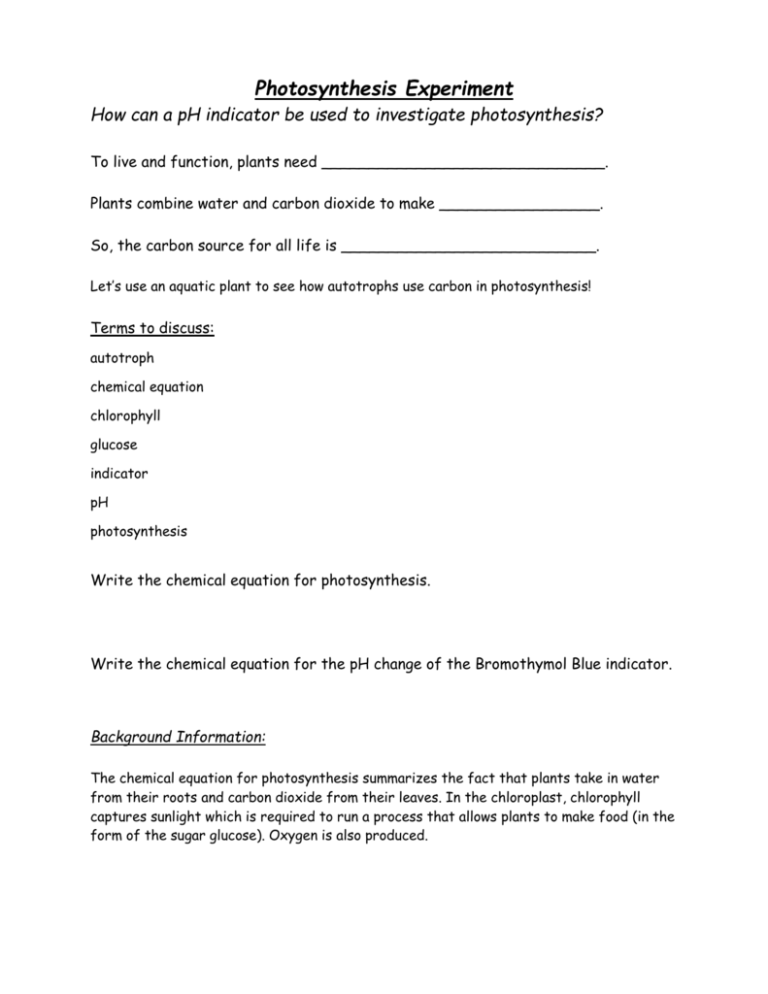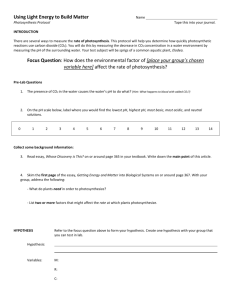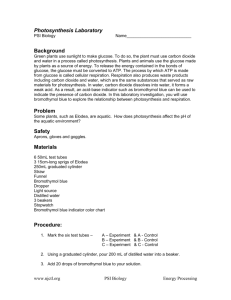Photosynthesis Experiment
advertisement

Photosynthesis Experiment How can a pH indicator be used to investigate photosynthesis? To live and function, plants need ______________________________. Plants combine water and carbon dioxide to make _________________. So, the carbon source for all life is ___________________________. Let’s use an aquatic plant to see how autotrophs use carbon in photosynthesis! Terms to discuss: autotroph chemical equation chlorophyll glucose indicator pH photosynthesis Write the chemical equation for photosynthesis. Write the chemical equation for the pH change of the Bromothymol Blue indicator. Background Information: The chemical equation for photosynthesis summarizes the fact that plants take in water from their roots and carbon dioxide from their leaves. In the chloroplast, chlorophyll captures sunlight which is required to run a process that allows plants to make food (in the form of the sugar glucose). Oxygen is also produced. Bromothymol Blue (BT Blue) pH indicator: When bromthymol blue is dissolved in water, it changes color to indicate the pH of the solution. pH: 2 4 6 8 10 12 ACID BASE -----yellow----------green-----blue--------How could the BT Blue pH indicator be used to experiment with photosynthesis? Discuss this with your group, and jot down your best ideas. Hmmm, how could we get carbon dioxide in the BT Blue solution? Question to test: Hypothesis: Class Experimental Design: Results: Teacher Notes: Photosynthesis Experiment How can a pH indicator be used to investigate photosynthesis? To live and function, plants need ___water, carbon dioxide, minerals, light_. Plants combine water and carbon dioxide to make _food (sugar, glucose)_. So, the carbon source for all life is __carbon dioxide or CO2 in the atmosphere_. Let’s use an aquatic plant to see how autotrophs use carbon in photosynthesis! Terms to discuss: autotroph – self feeder, refers to organisms like plants and algae chemical equation – shorthand method of writing the combination of reactant materials that combine in a chemical reaction chlorophyll-an oily compound in autotrophy cells that captures sunlight for photosynthesis glucose-a simple sugar molecule that plants make from water and carbon dioxide indicator-a chemical that changes color to “indicate” or show some change pH-the amount of acidity or alkalinity of a solution (from percent Hydrogen ion) photosynthesis-process by which light (photo) is used to make (synthesis) sugar from water and carbon dioxide Write the chemical equation for photosynthesis. 6H2O + 6CO2 -light C6H12O6 + 6O2 Write the chemical equation for the pH change of the Bromothymol Blue indicator. BT-Blue-H2O + CO2 BT-Yellow-H2CO3 Background Information: The chemical equation for photosynthesis summarizes the fact that plants take in water from their roots and carbon dioxide from their leaves. In the chloroplast, chlorophyll captures sunlight which is required to run a process that allows plants to make food (in the form of the sugar glucose). Oxygen is also produced. Bromothymol Blue (BT Blue) pH indicator: When bromthymol blue is dissolved in water, it changes color to indicate the pH of the solution. pH: 2 4 6 8 10 12 ACID BASE -----yellow----------green-----blue--------How could the BT Blue pH indicator be used to experiment with photosynthesis? Discuss this with your group, and jot down your best ideas. -----Hopefully students will come up with some design that seeks to measure photosynthesis of an aquatic plant submerged in BtBlue solution. As the plant takes CO2 out of the water, yellow indicator will turn blue. Hmmm, how could we get carbon dioxide in the BT Blue solution? Teacher gently blows into flask or beaker of bromthymol blue, until it turns yellow. Possible Questions to test: Will Elodea conduct photosynthesis in the dark? Is Elodea photosynthesis more effective in natural or artificial light? How does light intensity affect Elodea photosynthesis? Hypothesis: Varies relative to question chosen. Class Experimental Design: Above three possible questions can be tested with 2 plastic tubes, each filled with yellow indicator and equal length sprig of Elodea. The teacher should provide one tube of yellow indicator to serve as an experimental control. Elodea converts yellow indicator to blue color as it pulls CO2 out of solution in photosynthesis – color gradually changes over the course of 2-4 days; small volumes under bright lights work within an hour. Best results if fresh Elodea is placed under electric or natural light for a few days. Results:----Color change from yellow to blue should be interpreted as carbon fixation, or the Elodea’s photosynthetic conversion of carbon dioxide to the sugar glucose. Good opportunity to review concepts of dissolved substances (CO 2 dissolved in BTBlue solution and diffusion (CO2 moves from high concentration in the water to an area of lower concentration in the Elodea leaves). Some surprising (naïve ideas or “misconceptions) from bright 7 th graders: Prediction that Elodea will quickly die in darkness (focus on health of plant instead of the photosynthesis experimental test. (Incorrect) observation that sugar had accumulated at the bottom of the tube.








